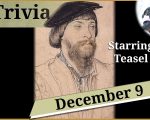
What did the Tudors wear as underwear?
Find out in this short video…
[Read More...]
Queen Elizabeth I and the Russian leader Ivan the Terrible had a rather volatile relationship. Find out more about it in this short video…
[Read More...]
In today’s Advent treat, I’m sharing a Teasel’s Tudor Trivia video about a tradition today that goes back to Cardinal Wolsey’s time, in the reign of King Henry VIII, and which concerns cats.
[Read More...]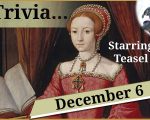
For today’s Advent treat, I thought I’d share this Teasel’s Tudor Trivia video about a very strange legend concerning Elizabeth I – The Bisley Boy Legend.
[Read More...]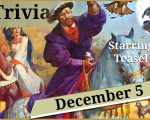
In “The Tudors” series, Henry VIII had a rather nasty accident and nearly drowned. This actually happened while the king was oput hawking in 1525.
Let me tell you more about it.
[Read More...]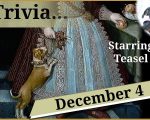
Did you know that Henry VIII was a dog-lover?
Yes, the king had two favourite dogs called Cut and Ball, and you can find out more about them in this video I did a few years ago with the help of Teasel the dog…
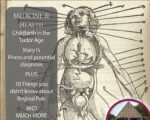
Medieval and Tudor people had some rather interesting remedies for common ailments, so, as today’s Advent treat, I thought I’d share these resources with you on Tudor medicine and remedies.
[Read More...]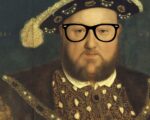
For today’s Advent treat, I’m sharing this Teasel’s Tudor Trivia video from a few years ago. It’s about Henry VIII and what he used to help him read as his eyesight worsened with age.
[Read More...]
A few years ago I did a virtual Advent calendar on YouTube with the help of my canine friend, Teasel. We shared Tudor trivia each day and I thought it would be good to share these videos again this year.
1st December is all about Tudor dogs…
[Read More...]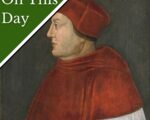
On this day in Tudor history, 18th October 1529, in the reign of King Henry VIII, Cardinal Thomas Wolsey surrendered the Great Seal of his office of Lord Chancellor following the writ of praemunire being filed against him on the 9th October.
Cardinal Wolsey had been the king’s chief advisor for many years, but he had fallen in favour after the Legatine Court of summer 1529, over which Wolsey and Cardinal Campeggio presided, had adjourned without ruling on the king’s case for an annulment of his marriage to Catherine of Aragon. Then, the pope had approved Catherine’s appeal. Historian Eric Ives, in his book “The Life and Death of Anne Boleyn”, also points out that Wolsey “lost Henry’s confidence from late August onwards by miscalculating the king’s mood and by mishandling the Treaty of Cambrai, in which Francis I totally deceived him and caused him, in turn, to mislead his master.”
[Read More...]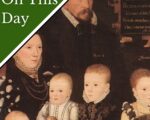
On this day in Tudor history, 17th October 1592, in the reign of Queen Elizabeth I, Frances Brooke, Lady Cobham, wife of William Brooke, 10th Baron Cobham, died. She was buried at Cobham.
Lady Cobham is known for being featured in the famous Elizabethan family portrait, The Cobham Family (1567), which depicts Frances, her husband, their six children, and her sister. She served Elizabeth I as Mistress of the Robes and Lady of the Bedchamber.
[Read More...]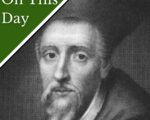
On this day in Tudor history, 16th October 1594, in the reign of Queen Elizabeth I, Cardinal William Allen died at his home in the via Monserrato, Rome, while in exile. He was buried in Rome, in the English College’s Church.
Allen founded the English Colleges at Douai and Reims and helped found the one at Rome, and supported a Spanish invasion of England.
[Read More...]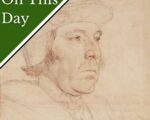
On this day in Tudor history, 15th October 1542, in the reign of King Henry VIII, courtier, diplomat and naval commander William Fitzwilliam, Earl of Southampton, died in Newcastle-upon-Tyne. It is thought that he was buried in Newcastle.
Fitzwilliam’s offices included Vice Admiral, Treasurer of the Household and Lord Privy Seal. He died while leading troops to Scotland under the command of Thomas Howard, 3rd Duke of Norfolk.
[Read More...]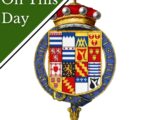
On this day in Tudor history, 14th October 1593, in the reign of Queen Elizabeth I, soldier and Lord Deputy of Ireland, Arthur Grey, 14th Baron Grey of Wilton, died at his home of Whaddon in Buckinghamshire. He was buried there.
Grey had a reputation for radical Protestantism.
[Read More...]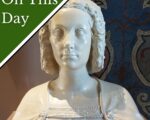
On this day in Tudor history, 13th October 1499, Queen Claude of France, wife of King Francis I of France and mother of King Henry II of France, was born in Romorantin-Lanthenay, in the Loire Valley in France.
Claude was the eldest daughter of King Louis XII of France and Anne of Brittany, but salic law prevented her from acceding to the throne of France on the death of her father in January 1515. Her husband and cousin, Francis, Duke of Angoulême, inherited the throne and so Claude became queen consort instead.
[Read More...]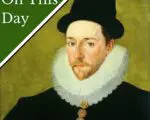
On this day in Tudor history, 12th October 1555, Peregrine Bertie, 13th Baron Willoughby of Willoughby, Beck, and Eresby, was born at Wesel in Cleves.
Bertie was the son of Richard Bertie and his wife, Katherine (née Willoughby), Duchess of Suffolk and widow of Charles Brandon, Duke of Suffolk. Bertie was born while his Protestant parents were in exile during Mary I’s reign.
[Read More...]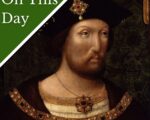
On this day in Tudor history, 11th October 1521, Pope Leo X conferred on King Henry VIII the title of Fidei Defensor, “Defender of the Faith”.
This was a reward for Henry VIII writing his pamphlet Assertio septem sacramentorum adversus Martinum Lutherum, “Declaration of the Seven Sacraments Against Martin Luther”, which was dedicated to the Pope. The pamphlet defended the Catholic Church against Reformer Martin Luther’s work, “De captivitate Babylonica”, “On the Babylonian Captivity of the Church”, which had been published in 1520.
[Read More...]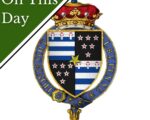
On this day in Tudor history, 10th October 1530, Thomas Grey, 2nd Marquess of Dorset, magnate, soldier and courtier, died. He was buried at Astley Collegiate Church in Warwickshire.
Grey’s offices included Constable of Warwick Castle and of Kenilworth Castle, and, as a skilled jouster, he also acted as Chief Answerer at the marriage of Prince Arthur and Catherine of Aragon. Grey was also the grandfather of Lady Jane Grey.
[Read More...]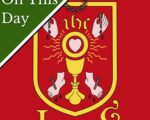
On this day in Tudor history, 9th October 1536, in the reign of King Henry VIII, the rebels of Horncastle, Lincoln, dispatched their petition of grievances to the king and also north into Yorkshire.
These were the rebels of the Pilgrimage of Grace rebellion, an uprising in the north of England which was sparked off initially by trouble in Lincolnshire. This trouble, in turn, was caused by discontent over the dissolution of Louth Abbey, the government commissions in the area and rumours that these commissions would confiscate jewels and plate from churches and impose new taxes.
[Read More...]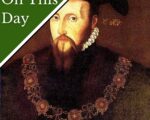
On this day in Tudor history, 8th October 1549, in the reign of King Edward VI, the king’s uncle, Edward Seymour, Duke of Somerset and Lord Protector, was proclaimed a traitor by the king’s privy council after he’d fled to Windsor Castle with Edward VI and called for troops to defend him and his charge.
[Read More...]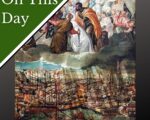
On this day in Tudor history, 7th October 1571, there was a naval battle just off the coast of southwestern Greece in the Mediterranean.
The Battle of Lepanto was fought between the Holy League, Christian forces led by Don Juan of Austria, and the Ottoman Empire, whose fleet were commanded by Uluch Ali, Mohammed Saulak and Ali Pasha.
[Read More...]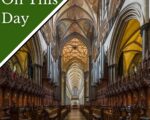
On this day in Tudor history, 6th October 1557, John Capon (also known as John Salcot), former Benedictine monk and Bishop of Salisbury, died, probably from influenza. He was buried in the choir at Salisbury Cathedral.
Capon appeared to have reformist leanings in the reigns of Henry VIII and Edward VI, but became a conservative Catholic again in Mary I’s reign, and was involved in the examination of those deemed to be heretics.
[Read More...]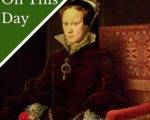
On this day in Tudor history, 5th October 1553, the first Parliament of Mary I’s reign met.
This Parliament repealed the “treason act” of Mary’s half brother Edward VI’s reign, passed an act declaring Mary’s legitimacy, repealed the religious legislation of Edward’s reign, and reinstated the Mass in Latin, celibacy of the clergy and ritual worship. It was as if the reformation of Edward VI’s reign had never happened.
[Read More...]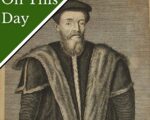
On this day in Tudor history, 4th October 1556, following five months of imprisonment, humanist, former royal tutor and former secretary of state Sir John Cheke made a public recantation of his Protestant faith in front of Queen Mary I and the royal court.
Cheke, who had tutored King Edward VI and served Queen Jane (Lady Jane Grey) as secretary of state, had been imprisoned in late July 1553 following Mary I’s accession for his part in putting Lady Jane Grey on the throne, but released in spring 1554. Mary I granted him a licence to go into exile abroad, which he did, travelling to Strasbourg, Basel, Padua and then back to Strasbourg.
[Read More...]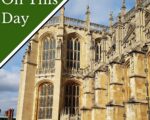
On this day in Tudor history, 3rd October 1559, Sir William Fitzwilliam, gentleman of King Edward VI’s privy chamber, died.
Fitzwilliam was a member of Parliament, a favourite of both the Duke of Somerset and Duke of Northumberland, and served Mary I as deputy chancellor in Ireland.
Here are a few facts about Sir William Fitzwilliam…
[Read More...]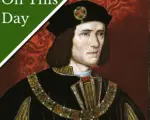
On this day in history, 2nd October 1452, King Richard III, the last Plantagenet king, was born at Fotheringhay Castle in Northamptonshire.
Richard was the youngest surviving child of Richard, 3rd Duke of York, and Cecily Neville.
Richard claimed the English throne in June 1483, claiming that his brother Edward IV’s sons were illegitimate because Edward had been pre-contracted to another woman, Eleanor Butler, when he married Elizabeth Woodville.
[Read More...]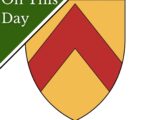
On this day in Tudor history, 1st October 1526, in the reign of King Henry VIII, Dorothy Stafford, Lady Stafford, was born.
Dorothy was the daughter of Henry Stafford, 10th Baron Stafford, and his wife, Ursula (née Pole, and she was married to Sir William Stafford, widower of Mary Boleyn. Dorothy served Queen Elizabeth I as a gentlewoman of the privy chamber and was one of her favourite sleeping companions.
[Read More...]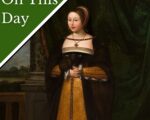
On this day in Tudor history, 30th September 1515, Margaret Tudor, sister of Henry VIII and former queen consort of King James IV of Scotland, fled from Scotland to England.
Margaret was pregnant with the child of her new husband, Archibald Douglas, 6th Earl of Angus, at the time.
Her remarriage had cost her the regency for her son, King James V, who had been born in 1512 and had become king on his father’s death in September 1513. John Stewart, 2nd Earl of Albany, took over as regent and had custody of the young king and his brother, Alexander. Margaret hoped that her brother, Henry VIII, would help restore her to the regency.
[Read More...]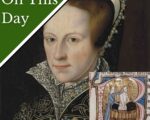
On this day in Tudor history, 29th September 1553, Michaelmas, the new queen, Mary I, created fifteen Knights of the Bath as part of her coronation celebrations.
Traditionally, knights were dubbed while naked in their baths, so Henry Fitzalan, 19th Earl of Arundel, represented Mary I at the ceremony.
You can find out who these fifteen men were, and more about the ceremony itself in an article
[Read More...]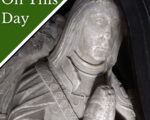
On this day in Tudor history, 28th September 1502, in the reign of King Henry VII, Robert Willoughby, 1st Baron Willoughby de Broke, died at Callington, Cornwall. He was buried at Callington Church.
Willoughby had been in exile in Brittany with Henry Tudor and fought with him at the Battle of Bosworth. He served Henry VII as Lord Steward and was made a Knight of the Garter in 1489.
[Read More...]